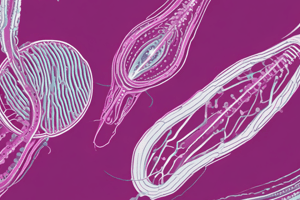Podcast
Questions and Answers
What is the primary type of organism that Chlamydia belongs to?
What is the primary type of organism that Chlamydia belongs to?
- Fungi
- Virus
- Obligate intracellular organism (correct)
- Gram-positive bacteria
Which transmission route is primarily associated with Chlamydia infections?
Which transmission route is primarily associated with Chlamydia infections?
- Fecal-oral route
- Airborne transmission
- Direct contact with infected fluids (correct)
- Vector-borne transmission
During which stage do Chlamydia organisms become intracellular?
During which stage do Chlamydia organisms become intracellular?
- Extracellular Phase
- Elementary Body (EB)
- Reticulate Body (RB) (correct)
- Infectious Burst Stage
What method prevents the fusion of the phagolysosome in Chlamydia's life cycle?
What method prevents the fusion of the phagolysosome in Chlamydia's life cycle?
Which characteristic is NOT true about Chlamydia species?
Which characteristic is NOT true about Chlamydia species?
What is the shape of Campylobacter species?
What is the shape of Campylobacter species?
What is a common characteristic of Chlamydia in terms of its survival?
What is a common characteristic of Chlamydia in terms of its survival?
Which method is used to diagnose Bovine Genital Campylobacteriosis?
Which method is used to diagnose Bovine Genital Campylobacteriosis?
Which animal is primarily affected by Taylorella equigenitalis?
Which animal is primarily affected by Taylorella equigenitalis?
Which of the following are potential clinical signs of Chlamydia infection in females?
Which of the following are potential clinical signs of Chlamydia infection in females?
What is a common clinical sign of Equine Arteritis Virus infection?
What is a common clinical sign of Equine Arteritis Virus infection?
Which route does Chlamydia NOT utilize for transmission?
Which route does Chlamydia NOT utilize for transmission?
Which species is known to carry Leptospira interrogans related to Leptospirosis?
Which species is known to carry Leptospira interrogans related to Leptospirosis?
What zoonotic effect can Chlamydia have on humans?
What zoonotic effect can Chlamydia have on humans?
Which species is primarily affected by C.abortus causing abortion?
Which species is primarily affected by C.abortus causing abortion?
What is a key characteristic of Campylobacter fetus venerealis infections in cows?
What is a key characteristic of Campylobacter fetus venerealis infections in cows?
What type of vaccine is available for Equine Arteritis Virus?
What type of vaccine is available for Equine Arteritis Virus?
What is the primary clinical concern regarding C.fetus venerealis?
What is the primary clinical concern regarding C.fetus venerealis?
What is the primary diagnostic method for Taylorella equigenitalis?
What is the primary diagnostic method for Taylorella equigenitalis?
Which of the following precautions is critical for veterinary professionals when handling situations involving Chlamydia infections?
Which of the following precautions is critical for veterinary professionals when handling situations involving Chlamydia infections?
Which species is NOT typically associated with Chlamydia infections?
Which species is NOT typically associated with Chlamydia infections?
Flashcards
Chlamydia
Chlamydia
A group of bacteria that require host cells to survive and reproduce. Affects various animals, including humans.
Chlamydophila
Chlamydophila
A genus of bacteria within the Chlamydiaceae family. Many chlamydophila species affect animals, humans, and birds.
Elementary Body (EB)
Elementary Body (EB)
The infectious form of Chlamydia, entering a host cell through receptor-mediated endocytosis.
Reticulate Body (RB)
Reticulate Body (RB)
Signup and view all the flashcards
Chlamydia Transmission
Chlamydia Transmission
Signup and view all the flashcards
Chlamydia in Small Ruminants
Chlamydia in Small Ruminants
Signup and view all the flashcards
C. fetus venerealis
C. fetus venerealis
Signup and view all the flashcards
C. fetus fetus
C. fetus fetus
Signup and view all the flashcards
Chlamydia: Zoonotic Potential
Chlamydia: Zoonotic Potential
Signup and view all the flashcards
Chlamydia: Precautions
Chlamydia: Precautions
Signup and view all the flashcards
PCR Testing for Chlamydia
PCR Testing for Chlamydia
Signup and view all the flashcards
Campylobacter jejuni
Campylobacter jejuni
Signup and view all the flashcards
Campylobacter fetus venerealis
Campylobacter fetus venerealis
Signup and view all the flashcards
Bovine Genital Campylobacteriosis
Bovine Genital Campylobacteriosis
Signup and view all the flashcards
Taylorella equigenitalis
Taylorella equigenitalis
Signup and view all the flashcards
Leptospirosis
Leptospirosis
Signup and view all the flashcards
Equine Arteritis Virus (EVA)
Equine Arteritis Virus (EVA)
Signup and view all the flashcards
Transmission of EVA
Transmission of EVA
Signup and view all the flashcards
EHV-3 Reproduction
EHV-3 Reproduction
Signup and view all the flashcards
EHV-3: External genitalia
EHV-3: External genitalia
Signup and view all the flashcards
EHV-3: Spread
EHV-3: Spread
Signup and view all the flashcards
EHV-3: No treatment
EHV-3: No treatment
Signup and view all the flashcards
Study Notes
Reproductive Infectious Diseases
- This is a study guide on reproductive infectious diseases in animals.
Organisms Covered
- The study will cover the following for each organism:
- Type of organism
- Transmission route
- Age and characteristics of affected animals
- Clinical signs (illnesses/symptoms)
- Disease control/prevention measures
- Available diagnostics and sample choices
Chlamydia
- Family: Chlamydiaceae
- Genera: Chlamydia and Chlamydophila
- Species: Many species affect animals, including C. abortus, C. avium, C. psittaci, C. felis, C. suis, C. buteonis, C. caviae, C. gallinacea, C. muridarum, C. pecorum, C. pneumoniae, C poikilotherma, C serpentis. C. trachomatis is in the Chlamydia genus.
- Obligate intracellular organism: They need a host cell to survive and reproduce.
- Gram-negative: But Gram staining is often poor.
- Transmission: Aerosolization, ingestion, and direct contact. Secretions (even dried) and feces can persist in soil and feces for extended periods.
- Reproductive Clinical Signs (Females): Endometritis, metritis, abortion, stillbirth.
- Reproductive Clinical Signs (Males): Orchitis, epididymitis, urethritis. This can lead to infertility or poor reproductive performance.
- C. abortus: Most common cause of abortion in small ruminants (sheep and goats). Often associated with "Ovine Enzootic Abortion."
- Zoonotic potential: Chlamydia can affect humans, food-producing animals, companion animals (especially cats), mammalian wildlife, and avian, reptile, amphibian, and aquatic species. Humans can experience fever, headache, pneumonia, C. psittaci causing splenic enlargement, and C. abortus associated with abortion in women.
- Precautions: Use personal protective equipment (PPE) when handling animals with possible chlamydial infections and especially abortions in ruminants (cows, sheep, goats). Communicable to people via contact with shedding caged pet birds.
Campylobacter
- Species: C. fetus venerealis (only in the reproductive tract), C. fetus fetus (gastrointestinal [GI] tract, sometimes reproductive tract), C. jejuni (GI tract, sometimes reproductive tract).
- Bacteria shape: Curved, "C-" or "S"-shaped.
- Gram stain: Negative
- Growth conditions: Microaerophilic (limited oxygen)
- Motility: Polar flagella (whip-like structures) leading to wet/spreading colonies on culture.
- Reproductive Signs (Bulls): Inapparent infections of the penis and prepuce (area around the penis)
- Reproductive Signs (Cows): Clinical signs mostly apparent in naïve cows, meaning those without established immunity. There is local IgA and prolonged shedding of bacteria possible, and co-infection with Trichomonas is possible.
- Bovine Genital Campylobacteriosis: Mucopurulent endometritis (inflammation of the uterus), infertility, early embryonic death, and abortion are possible. Diagnostic challenge: low counts. Diagnostics include culturing fetal stomach contents & vaginal mucus agglutination tests. Prevention: Vaccination or artificial insemination.
Ovine Cases
- Data on ovine (sheep) cases with Campylobacter. Includes percentages and occurrences of gross/microscopic findings like placentitis, bacterial colonies, vasculitis, supple, liver pneumonia, and more.
Taylorella equigenitalis
- Gram stain: Negative (rod or cocci)
- Cause: Contagious Equine Metritis (CEM)
- Status: Largely eradicated from the U.S. via testing and quarantine.
- Infected Areas: External genitalia, specifically the urethra, urethral fossa, penile sheath of stallions, clitoral fossae of mares.
- Diagnosis: Culture and serology from federally approved labs.
Leptospirosis
- Species affected: Abortion in multiple animal species, such as skunks ( Leptospira interrogans sub-species Kennewecki), raccoons (Leptospira interrogans sub-species Gryppotyphosa), and cattle (Leptospira interrogans sub-species Hardjo).
Equine Arteritis Virus (EVA)
- Virus family: Arteriviridae
- Host: Horses, camelids
- Clinical signs: Acute upper respiratory infection, fever exceeding 105°F, conjunctivitis, nasal discharge, leukopenia (low white blood cell count), dependent edema, abortions, and urticaria (hives).
- Transmission: Venereal, frozen semen & horizontal/lateral spread (between animals that are close). Saddlebreds and Standardbreds are potentially susceptible. Carriers including stallions are possible.
- Diagnosis: Virus isolation or RT-PCR analysis on blood or tissue samples.
- Treatment: Most horses recover without treatment, but antibiotics can prevent secondary infections.
- Prevention: Vaccines are available for attenuated and inactivated strains. Vaccination of colts (young male horses) and mares (female horses) before breeding are effective strategies.
EHV-3
- Virus type: Herpesvirus
- Infected Area: Reproductive tract, specifically superficial external genitalia. Stallions and mares can be affected.
- Transmission: Skin-to-skin contact.
- Treatment: No specific treatment exists.
Studying That Suits You
Use AI to generate personalized quizzes and flashcards to suit your learning preferences.
Related Documents
Description
This quiz provides an overview of reproductive infectious diseases in animals, focusing on various organisms like Chlamydia. It covers transmission routes, clinical signs, characteristics of affected animals, control measures, and diagnostic options. Engage with this material to enhance your understanding of animal health.




